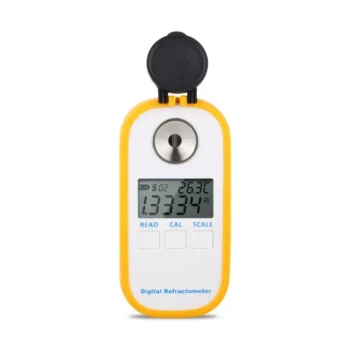Yes, honey actively draws moisture from its environment. This property is known as hygroscopicity, a direct result of its high concentration of sugars and low water content. Because of this, an open container of honey will absorb water vapor directly from the air, especially in a humid setting.
Honey's ability to absorb moisture is its greatest strength and its primary vulnerability. This hygroscopic nature is what makes it an excellent natural preservative, but it's also what puts it at risk of fermentation if not stored correctly.

The Science of Honey and Water: Hygroscopicity Explained
What "Hygroscopic" Really Means
At its core, honey is a supersaturated solution of sugars, primarily fructose and glucose. It has a very low natural water content, typically below 18%.
This low water concentration creates a powerful osmotic effect. Honey instinctively seeks to balance its water content with that of its surroundings, pulling in water molecules from the air to achieve equilibrium.
How This Property Preserves Honey
Honey's hygroscopic nature is the secret to its legendary shelf life. When microorganisms like bacteria or yeast land in honey, it immediately draws the water out of their cell walls.
This process, called osmosis, effectively dehydrates and destroys the microbes, preventing them from multiplying and causing spoilage.
The Risk: When Honey Absorbs Too Much Moisture
The Danger of Fermentation
While honey contains natural, dormant yeasts, they cannot survive in its low-moisture environment.
However, if honey is left unsealed in a humid environment, it can absorb enough atmospheric water to raise its moisture content above a critical threshold (around 19-20%). This dilution allows the dormant yeasts to activate and begin the process of fermentation, spoiling the honey.
Why Proper Storage is Non-Negotiable
Fermented honey is characterized by a sour taste and bubbly appearance. While it might be suitable as "baker's honey," it is no longer fit for consumption as table honey.
The only way to prevent this is by storing honey in a sealed, airtight container. This creates a barrier between the honey and the moisture in the ambient air, preserving its natural low-water state indefinitely.
Understanding the Trade-offs in Moisture Management
The Beekeeper's Challenge
For beekeepers, managing moisture is a critical step in production. Honey harvested too early may have a naturally high water content, making it susceptible to fermentation.
Producers must ensure the moisture level is below the safe threshold before bottling. They often use tools like refractometers to measure water content precisely.
Methods for Moisture Reduction
If honey is harvested with excess moisture, producers can use specific techniques to reduce it.
This can be done by placing the honey in a sealed room with a dehumidifier and stirring it periodically. For larger operations, specialized honey dryers use a cycle of warm, dry air to gently evaporate and remove excess water.
The Benefit in Baking
In culinary applications, particularly baking, honey's hygroscopic nature is a major advantage.
When used in recipes for cakes, muffins, or bread, honey continues to draw moisture from the air. This helps the final product retain its moisture, resulting in baked goods that stay fresher and softer for longer.
How to Manage Honey's Moisture for Your Goal
Understanding this core principle allows you to control for it based on your specific needs.
- If your primary focus is long-term storage: Always keep honey in a securely sealed, airtight container in a dry place to prevent it from absorbing atmospheric moisture.
- If your primary focus is beekeeping or harvesting: Measure the honey's water content and, if necessary, use a dehumidifier or dryer to reduce it to below 18% before bottling for sale.
- If your primary focus is baking: Leverage honey's hygroscopic properties to create baked goods that have a longer-lasting moist texture.
Ultimately, mastering honey's relationship with water is the key to preserving its quality and capitalizing on its unique benefits.
Summary Table:
| Aspect | Key Takeaway |
|---|---|
| Property | Hygroscopic (absorbs moisture from the air) |
| Primary Risk | Fermentation if moisture content exceeds ~19% |
| Storage Solution | Airtight container in a dry place |
| Beekeeping Focus | Harvest & bottle honey with <18% moisture content |
| Baking Benefit | Keeps baked goods moist and fresh for longer |
Are you a commercial beekeeper or distributor focused on honey quality? Proper moisture management is critical for preventing spoilage and ensuring product integrity. HONESTBEE supplies professional beekeeping equipment, including refractometers for precise moisture testing and storage solutions designed to protect your harvest. Let us help you safeguard your product from hive to table. Contact our experts today to discuss your apiary's needs.
Visual Guide

Related Products
- Precision Honey Refractometer Instrument for Quality Assessment
- Digital Honey Refractometer for Precision Measurement of Optimal Honey Quality
- Natural Wood Honey Dipper for Tea Coffee and Desserts
- Inverted Squeezable Honey Jar with No Drip Flip Top Cap for Easy Pouring
- Easy Use Manual Stainless Steel Honey Press for Honey Comb
People Also Ask
- Why is a honey refractometer important for beekeepers? Ensure Quality and Prevent Fermentation
- What are the key points for proper usage of a honey refractometer? Ensure Accurate Moisture Readings Every Time
- What is a honey refractometer and what is its purpose? Ensure Honey Quality and Prevent Spoilage
- What are the key steps to using a honey refractometer? Ensure Honey Quality & Prevent Fermentation
- Why is a honey refractometer essential for honey harvesting? Protect Your Harvest from Spoilage



















